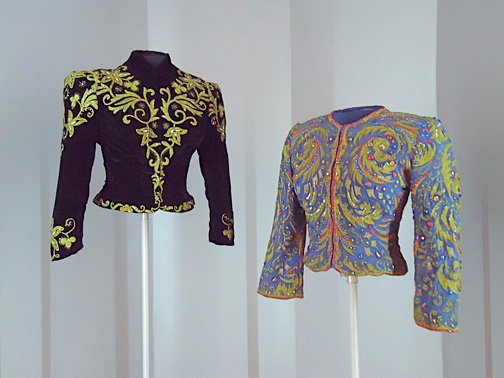
A pair of jackets designed for Marlene Dietrich by Travis Banton, 1938-40.
By Susan JAMES
A new exhibition of costume sketches from the Golden Age of Hollywood in the collection of Christian Esquevin has just opened at the Fashion Institute of Design and Merchandising in Los Angeles. Running through Nov. 1, over 100 original sketches of costumes from the late 1920s through the ‘60s created by such legendary designers as Edith Head, Adrian, Orry-Kelly, Helen Rose and Jean Louis are on display together with a selection of film costumes from FIDM’s own collection.
Since the beginning of movie-making, the costume designer has been called upon to create a character, a time and a place through fabric. Producers, directors and actors all have their own ideas about how that character and their clothes should look. Stars who have the right of approval over their costumes are protective of their image and the outfits designed for a film must flatter as well as perform. For historical extravaganzas from the 1920s or ’30s, the designer had to make the actor look believable as a Roman charioteer, a Tudor queen or a Turkish slave girl while still allowing them to look relevant to a contemporary audience. When a film was set in the modern day, the challenge for the designer was to create a look so stunning that it would set a fashion trend off-screen.
One of Hollywood’s talented army of costume creators during its Golden Age was Marie Ree, head fitter at RKO and aunt of the owner of the collection. She bequeathed her collection of drawings and photos to Esquevin, work that was usually thrown away after a film was completed. Esquevin became fascinated by the art and history of the drawings and began to collect on his own. Each drawing tells the story of a film and the people who created it.
The elaborate sketch for Bebe Daniels by Orry-Kelly for the 1933 musical “42nd Street,” complete with fur trim and massed fox tails drooping across the shoulders, had been signed off by Daniels, but the foxtails had been ruthlessly edited with pencil and “Out” scrawled on the sketch. Mary Ann Nyberg’s 1953 costume for Cyd Charisse for the “Dancing in the Dark” number with Fred Astaire in “Bandwagon” shows how the dress would move during that dance.
Each drawing also tells of the change in fashions and in drawing style. The polished perfection of Irene Lentz Gibbons’ sketch for a dress worn in “Easter Parade” (1948), complete with white gloves, wide-brimmed portrait hat and a small dog on a leash, is a world away from the casual scrawl of Edith Head’s design for Natalie Wood in “Sex and the Single Girl.” But impressions of glamour could remain surprisingly constant. A white satin evening gown designed by Renie in 1968 for Kim Novak in “Lylah Clare” is strikingly similar to Adrian’s code-shattering 1931 white satin slip dress worn by Norma Shearer in “A Free Soul.”
FIDM museum curator Kevin Jones slipped an insider joke in here and there. Bette Davis as the drama diva in “All About Eve” (1950) wears an Edith Head design in a sketch that hangs next to an actress she famously detested, Joan Crawford, wearing a Jean Louis costume for “Queen Bee” (1955). Imagining the evil looks that would have passed between these two queens of the silver screen is just one reason to catch this show of rarely seen wonders.
